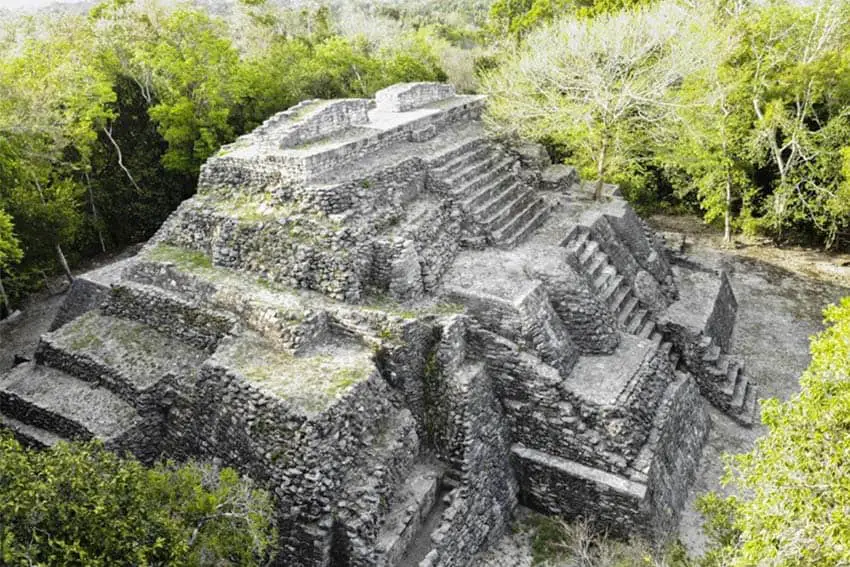Mexico opening ancient Maya site Ichkabal to public for first time

The ancient Maya city of Ichkabal — an archaeological site that is larger and has three more pyramids than Chichén Itzá’s Temple of Kukulcán — is poised to become a major Mexican tourist attraction after its scheduled opening to the public next month.
Although Ichkabal was discovered nearly 30 years ago, this will be the first time visitors will be allowed into one of the oldest Maya archeological sites in Mexico.
Located in the southeastern state of Quintana Roo, in the middle of the jungle 43 kilometers (27 miles) from Bacalar, Ichkabal isn’t as easily accessible from cities such as Cancún, Tulum and Mérida as its more famous counterpart as Chichén Itzá is.

But with towering structures that have led it to be dubbed “the Mesoamerican Egypt,” Ichkabal will offer an unparalleled glimpse into a city that played a crucial role in the early development of Maya civilization. And government officials are promising easier access once the under-construction Maya Train finishes work on stations in Bacalar and Chetumal.
Covering 30 square kilometers — a footprint three times larger than Chichén Itzá — Ichkabal is one of the largest of Mexico’s archaeological sites still standing and one of the oldest vestiges of Maya culture.
The site is tentatively scheduled to open to the public on Sept. 14.
Work is being carried out to finalize transportation options from the yet-to-be-completed Maya Train station in Bacalar. The drive from the Bacalar station, however — over small jungle roads — will take approximately one hour and 45 minutes.
The site is also 81 kilometers (50 miles) from the Quintana Roo capital of Chetumal, but driving from the still-under-construction Chetumal station will take about two hours and 30 minutes.
Moreover, work on the southern part of the Maya Train’s section 5 — which will connect Quintana Roo’s northern resort cities with Bacalar and Chetumal to the south — was only about 65-70% complete as of earlier this week.
¡Buenos días! Con mucha emoción les comento que #Ichkabal muy pronto detonará el crecimiento económico y de infraestructura del sur de #QRoo pic.twitter.com/aDQ3Tezc4U
— Carlos Joaquín (@CarlosJoaquin) July 26, 2017
Some images of the soon-to-open Ichkabal, one of Mexico’s oldest Maya archaeological sites, discovered in 1995 but only now becoming accessible to the general public. (Mexico’s Ambassador to Canada Carlos Joaquin/Twitter)
Still, Alan Maciel Vallejo, a researcher with the National Institute of Anthropology and History (INAH), predicts that Ichkabal will attract a significant number of visitors, including cruise ship passengers from Mahahual (a nearly three-hour drive away).
Chichén Itzá, wrote the newspaper El País, “has new competition.”
The No. 1 visited archaeological site in Mexico, Chichén Itzá had 2.3 million visitors in 2023 and 1.18 million in the first half of 2024.
Ichkabal remained hidden beneath the jungle canopy until its discovery in 1995.
Since then, archaeologists have been working to uncover and preserve its monumental structures, built between 350 B.C. and 50 B.C.
The site’s intricate buildings and advanced hydraulic systems — such as a recently discovered cistern used to store water and corn — reveals the city’s importance as a political and cultural hub.
The site’s restoration has been part of the Program for the Improvement of Archaeological Zones (Promeza), a government initiative aimed at preserving and promoting Mexico’s rich cultural heritage. With the support of the Defense Ministry (Sedena), archaeologists are working feverishly to ensure that the site is ready to open soon.
However, it perhaps bears noting that the word “soon” was used in a Mexico News Daily headline nearly two years ago, when projections were that Ichkabal would open to the public by mid-2023.
But archaeology buffs have options while they wait: Earlier this year, the Chichén Itzá Maya Museum opened, as did a new museum at the archaeological site of Edzná in the state of Campeche. And last year, a newly unearthed complex at the Uxmal archaeological zone in Yucatán opened to the public.
Also, earlier this year, the Yaxchilan site in Chiapas — in the Lacandon Jungle near the Guatemala border — reopened after being closed for five months due to cartel violence in the region.
With reports from El País and Novedades Quintana Roo
Source: Mexico News Daily

